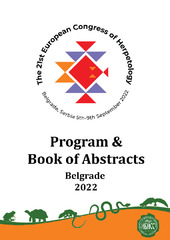Приказ основних података о документу
Seasonal variation in ecophysiology of the lizard Podarcis tauricus
| dc.contributor | Crnobrnja-Isailović, Jelka | |
| dc.contributor | Vukov, Tanja | |
| dc.contributor | Vučić, Tijana | |
| dc.contributor | Tomović, Ljiljana | |
| dc.creator | Ćorović, Jelena | |
| dc.creator | Ćosić, Nada | |
| dc.creator | Crnobrnja-Isailović, Jelka | |
| dc.date.accessioned | 2023-05-26T11:11:33Z | |
| dc.date.available | 2023-05-26T11:11:33Z | |
| dc.date.issued | 2022 | |
| dc.identifier.isbn | 978-86-80335-19-3 | |
| dc.identifier.uri | http://radar.ibiss.bg.ac.rs/handle/123456789/5709 | |
| dc.description.abstract | During thermoregulation reptiles suffer evaporative water loss (EWL) and the intensity of water loss depends on the temperature and the humidity of the habitat. As evaporation increases with temperature, the EWL could constrain the activity of ectotherms when water is not available. The thermal preference of a species and its resistance to water loss can remain similar under different environmental conditions and over time, or they can change depending on a variety of factors. One of the most important factors regarding temperate climate is its seasonality, and ectotherms living in such climate may be adapted to the seasonal fluctuations in the environment and show different physiological responses depending on the season. During spring (May) and autumn (September) we observed two ecophysiological traits of the Balkan wall lizard (Podarcis tauricus): preferred body temperature (Tpref) with set-point range (Tset), and EWL rates (instantaneous evaporative water loss – EWLi and accumulated evaporative water loss – EWLa). In these experiments we analyzed only adult males. Our findings showed that the thermal preference of P. tauricus was conserved between the seasons, as Tpref and Tset were quite similar in May and September (Tpref May: 21.5°C-36.1°C and Tpref September: 21.0°C-35.9°C; Tset May: 28.6°C-32.5°C and Tset September: 28.7°C-32.6°C). Overall hourly rates of evaporative water loss were lower in September and EWLi was also with fewer oscillations in the autumn. Mann-Whitney U test showed a significant difference in the total EWLa (p < 0.05). The analyzed lizards lost, on average, 2% and 1.2% of body weight in May and September, respectively. These results indicate that there might be a seasonal change in the sensitivity to water loss that enables the species to lose less water during the drier season. | sr |
| dc.language.iso | en | sr |
| dc.publisher | Belgrade: Institute for Biological Research "Siniša Stanković" – National Institute of Republic of Serbia, University of Belgrade | sr |
| dc.relation | info:eu-repo/grantAgreement/MESTD/inst-2020/200007/RS// | sr |
| dc.rights | openAccess | sr |
| dc.source | Program and Book of Abstracts: the 21st European Congress of Herpetology; 2022 Sep 5-9; Belgrade, Serbia | sr |
| dc.subject | preferred temperatures | sr |
| dc.subject | thermoregulation | sr |
| dc.subject | evaporative water loss | sr |
| dc.title | Seasonal variation in ecophysiology of the lizard Podarcis tauricus | sr |
| dc.type | conferenceObject | sr |
| dc.rights.license | ARR | sr |
| dc.rights.holder | © 2022 Institute for Biological Research "Siniša Stanković" – National Institute of Republic of Serbia, University of Belgrade | sr |
| dc.description.other | Crnobrnja-Isailović J, Vukov T, Vučić T, Tomović Lj, editors. Program and Book of Abstracts: the 21st European Congress of Herpetology; 2022 Sep 5-9; Belgrade, Serbia. Belgrade: Institute for Biological Research "Siniša Stanković"– National Institute of Republic of Serbia, University of Belgrade; 2022. p. 165. | sr |
| dc.citation.spage | 165 | |
| dc.type.version | publishedVersion | sr |
| dc.identifier.fulltext | https://radar.ibiss.bg.ac.rs/bitstream/id/12960/2022_Kongres_Beograd_Jelena.pdf | |
| dc.citation.rank | M34 | |
| dc.identifier.rcub | https://hdl.handle.net/21.15107/rcub_ibiss_5709 |

